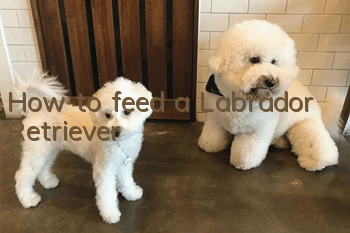How to feed a Labrador Retriever

1. Pay attention to dietary issues
To raise a dog well, no matter what you raise, you must first consider dietary issues. When choosing a dog you like, you must know the vitamins and healthy dog food your dog needs. Then there is the issue of feeding. You should not feed your Labrador anything too greasy, and you should also be careful not to have too much salt. Also, Labradors have a large appetite. Even if they have a large appetite, they cannot feed human food at will. It is not good for the dog's health. You should choose some natural dog food that is low in salt and oil. You can also feed some fruits and vegetables and milk powder on a regular basis, so that the dog's nutrition is very comprehensive.
2. Don’t feed snacks randomly
Lala is very greedy and wants to eat everything she sees, but it is not recommended to feed her snacks frequently. Snacks can be used as prizes, and you can feed Lala some when necessary. Lala has a huge appetite, so dog food should be the staple food and should be fed regularly and quantitatively.
3. Satisfy the amount of exercise
Labrador is a medium-sized dog that needs exercise every day, and the amount of exercise is particularly large. When feeding a dog, you should also pay attention to feeding it dog food with a relatively high calcium content, because a large amount of exercise will damage the bones that have not been fully calcified. Too much pressure. It is more appropriate for adult dogs to exercise for 1-2 hours a day. Go out for a walk (run), and pay attention to replenishing water every half an hour. Otherwise, if you are short of water for a long time, you will be more likely to suffer from heatstroke or be unwilling to exercise.
4. Take good care of your hair
Labradors will experience normal physiological hair loss, which is unavoidable. In order to better adapt to the season, Labrador dogs will shed and change hair when the seasons change, especially when the two seasons transition from spring to summer and autumn to winter. Labradors shed hair when the two seasons alternate. The symptoms are the most severe, so comb it in time every day to promote the healthy growth of new hair.
Nutritional imbalance, lack of protein, vitamins, minerals and other nutrients can also cause hair loss in lesbians. Pay attention to supplementing the dog's nutrition. You can make some goat milk powder for the dog to drink, or mix it with dog food to feed it. This can add more calcium, protein and various trace elements to the dog. There are many types of goat milk powder, and the market is quite confusing. Many businesses mix milk ingredients into it, which can cause problems such as diarrhea in dogs.
When bathing a Labrador at home, use a dog-specific bath gel. Using human shower gel to bathe the dog for a long time will damage the dog’s hair and skin, because the pH level of Labrador and human skin is Differently, using human bath products will wash off the protective film on the surface of the dog's skin.
5. Provide adequate companionship
We all know that Labradors are very clingy. As long as you live with Lala, it will never "let you go" and it especially likes to lick people. Lala licks your face to show friendliness. If you can't accept this, you can train the dog more to correct it. . As a dog owner, you also spend more time with it. Perhaps the most important thing for a dog is its owner. They also want to be accompanied by their owner and receive more care and care.
- Is it better for Dogo dogs to have their ears erect or cropped? A case of Dogo dog’s ear erection surgery will tell you
- What do dogs eat to protect their stomach? It is important to protect their stomach and treat gastrointestinal diseases in dogs.
- How to tell if your dog is fat? Is your dog overweight?
- How to train Tibetan Mastiff Four aspects teach you how to train Tibetan Mastiff
- Will your dog catch a cold if you blow the air conditioner? What should you do if your dog catches a cold if you blow the air conditioner?
- What should you pay attention to when your dog drinks water? Don’t be careless when it comes to your dog’s drinking water.
- The dog's mouth bites and shakes. Why does the dog's mouth occasionally shake and bite?
- How to cut a dog's hair? Do you know how to cut a dog's hair correctly?
- Can dogs eat raw eggs? Why can’t dogs eat egg whites?
- Common Dog Problems in Summer How to Deal with Different Dog Problems



